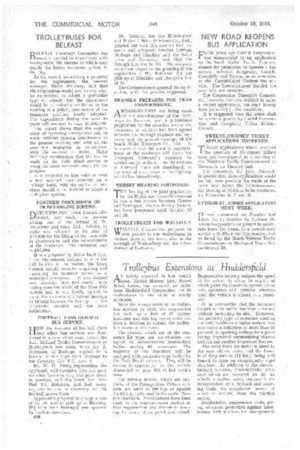Trolleybus Extensions at Huddersfield
Page 60

If you've noticed an error in this article please click here to report it so we can fix it.
AS briefly reported in last week's issue, Karrier Motors, Ltd., Biscot Road, Luton, has received an .order from Huddersfield Corporation for 85 trolleybuses to the value of nearly 1100,000.
Since the inauguration of its trolleybus services in 1939, the corporation has built up a fleet of 37 Karrier machines and this big repeat order follows a decision to extend the trolleybus routes in the town.
The chassis, which are of the concern's E6 type, are six-wheelers designed to accommodate double-deck bodies seating 64 passengers. The majority of the machines will be equipped with composite-type bodies by the Park Royal concern. They will be similar in appearance to the vehicle illustrated •on page 319 of last week's issue.
The driving motors, which are products of the Metropolitan Vickers concern, are rated at 100 h.p. as against the 80 h.p. units used in the earlier Karrier machines. Modifications have been made to the traction-motor control so that regenerative and rheostatic braking, by means of one pedal, is obtained. Regenerative braking reduces the speed of , the vehicle to about 14 m.p.h., at which point the rheostatic system comes into operation and remains effective until the vehicle is almost at a standstill.
It is noteworthy that the increased output of the motor has been obtained without increasing its size. Moreover, the patented type of armature winding not only results in a higher output, but also shows a reduction of more than 75 per cent, in sparking voltage for a given rating; improved commutating characteristics are another important feature.
The drive from the motor is offset to the worm-driven axles, and the frame is of deep secti .an (12 ins.), being well braced to form an exceptionally rigid structure. In addition to the electricbraking systems, pneumatically operated Crakes are provided on all six wheels; a further safety measure•is the incorporation of a runback and coasting brake, the retardation power of which is derived from the traction motor.
Incidentally, suppression coils, giving adequate protection against interference with wireless, are incorporated.




























































































